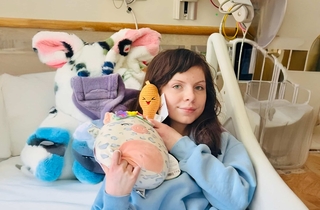Gabby’s Story: Renal Vein Transposition Surgery for Nutcracker Syndrome
Gabby’s Story: Renal Vein Transposition Surgery for Nutcracker Syndrome
When Gabby was 8, she began complaining of side pain after horseback riding lessons. For a while, her mom chalked it up to muscle soreness, a natural result of the physical demands of jumps and other riding techniques that require a lot of core strength. But over time, the symptoms became harder to ignore. Gabby started experiencing frequent urinary tract infections (UTIs), blood in her urine and excruciating abdominal pain, especially after exercise or gym class. These issues soon disrupted her entire life.
“She was constantly in pain,” says her mom, Danielle. “We eventually had to pull her out of horseback riding. I’d have to pick her up from school after gym. Her quality of life was suffering. It took a while for us to put the pieces together and realize something more serious was happening.”
Searching for answers
After being told repeatedly that it was just UTIs, Gabby ended up in her local ER twice. During the second visit, Danielle asked for a more thorough examination. A urologist eventually ordered an ultrasound, which suggested Gabby had a condition called Nutcracker syndrome.
In this condition, a vein that drains blood from the kidneys (the left renal vein) gets compressed, usually between two big blood vessels in the abdomen (the aorta and the superior mesenteric artery). Severe compression can lead to chronic pain, blood in the urine, and, in rare cases, kidney damage.
To evaluate the severity of compression, doctors can use numerous diagnostic tests, including ultrasound, CT and MRI scans. They may also recommend tests that are more invasive but provide more information, such as venogram and intravascular ultrasound.
Gabby was referred to pediatric vascular surgeon, Alexander Fairman, MD, Director of Pediatric Vascular Surgery at Children’s Hospital of Philadelphia (CHOP). Dr. Fairman leads one of the only comprehensive pediatric vascular surgery programs in the nation. After a thorough workup, it was determined that Gabby’s left renal vein compression was severe and the culprit of her symptoms.
A complex procedure and brave recovery

Gabby underwent a left renal vein transposition. In this surgical procedure, Dr. Fairman moved the left renal vein to a location lower in her abdomen where it would no longer be compressed. The surgery involved an incision over the middle of her abdomen. The first few days of recovery after the procedure were “grueling,” says Danielle. But Gabby started feeling better quickly.
“She was up walking by day two,” says Danielle. “Two weeks later, she came into the kitchen and said, ‘Mom, I just ran around, and I don’t have pain anymore.’ I cried when she walked away.”
That moment marked a profound shift. For the first time in years, Gabby wasn’t living in pain. Less than two months after surgery, the girl who once couldn’t make it through gym class was able to swim and run freely during spring break in Florida.
Care that goes beyond medicine
Reflecting on their journey, Danielle is deeply grateful — not only for the surgical success but for the extraordinary care they received.
“Dr. Fairman was unbelievable,” she says. “He’s brilliant, but also down to earth. He explained everything to us. He gave us his cellphone number, and I would text him questions. He responded to every text, day and night. He always talked to Gabby directly, made her laugh and made sure she felt comfortable.”
That level of connection mattered. It turned fear into trust, and it took the family from a terrifying diagnosis toward healing.
“You don’t see that kind of care often,” says Danielle.
It wasn’t just Dr. Fairman. The entire care team showed a level of compassion and attentiveness that made all the difference.
“They aren’t just medical professionals. They are compassionate, supportive and truly invested in Gabby’s future,” says Danielle. “They treated us like we were family, not just patients.”
Living without pain
Looking back, Danielle knows that speaking up and pushing for answers made all the difference in getting her daughter the care she needed.
“If I didn’t push for more tests, I don’t know if she would have been diagnosed,” she says. “It’s a rare condition. You need trained eyes and the right technology.”
Gabby now lives each day without pain. She can’t wait to get back to horseback riding soon!
“She is forever grateful to Dr. Fairman,” says Danielle. “She told me, ‘He fixed me, Mom. He gave me a second chance at life.’”
That second chance is what the family hopes to offer others by telling their story.

Expert care
A dedicated vascular surgery team
When a child or teen has a condition that affects the arteries and veins (also called the vascular system), vascular surgery can be a potential treatment option. CHOP's vascular surgery team has extensive experience helping kids with all kinds of blood vessel problems. Learn how we can help.